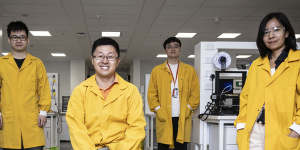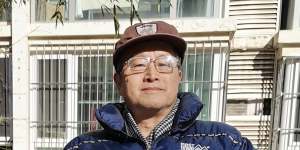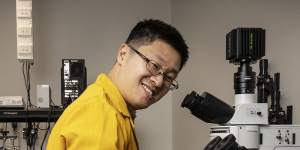His father,Li,had suffered a heart attack. He was 54.
The shock of his father’s illness changed Ju’s academic trajectory forever. He switched his career focus from mechanical engineering to the physics at work in our bodies.

Professor Arnold Ju (seated) with Yunduo Charles Zhao,Zichen Li and San Seint Seint Zhao in their research lab at the University of Sydney.Jessica Hromas
Fifteen years later,the now 36-year-old University of Sydney associate professor is developing a finger-prick blood test that could have predicted the disaster brewing in his father’s bloodstream.
“Everything happened so quickly. There were no symptoms. There was nothing I could do about it,” Ju said of his father’s heart attack. “I started wondering if we could’ve known earlier.”
Ju has received $8 million in funding from The Snow Medical Research Foundation to build a device with his team at the university that can quickly detect dangerous changes in a patient’s blood.
Snow Medical is a not-for-profit founded by Canberra businessman and philanthropist Terry Snow that grants long-term funding to biomedical research.

Arnold Ju’s father,Li Ju,had a heart attack when he was 54,which inspired his son to investigate the mechanical forces in our blood.Supplied
During his PhD,Ju developed a microcapillary (a tiny glass tube) and nanopositioning tools that could pinch a single platelet from a blood sample.
He used the tools to study how the mechanical forces of heart contractions,blood flow and pressure can activate platelets,the disc-shaped blood cells that clump together and cause clots.
“By poking or pushing this single platelet,which is about two micron[two millionths of a metre] in size,we can observe the platelet’s response to different forces,” he said.
“All these mechanical forces in our system are very critical,but there’s no available technologies to help elucidate how these forces trigger clotting.”
Armed with a greater understanding of how platelets and other blood cells behave before a stroke or heart attack,Ju started developing a blood test that can produce results in as little as 10 minutes to inform whether someone needs to go to hospital or take blood thinners.
The goal of his research is to create a hand-held device similar to at-home blood sugar tests used by people with diabetes. A 3D-printed testing chip could also be incorporated into a cassette resembling a rapid antigen test.
The chip would test for the three elements of blood clotting – hypercoagulation or “stickiness” in the blood,damage to vessel walls and interrupted blood flow.

Arnold Ju at work in his lab in Sydney.Jessice Hromas
“The COVID rapid antigen test really saved the burden for the NSW healthcare system,” Ju said. “We could use nanotechnologies,microtechnologies,to miniaturise the blood clotting test.
“That is the dream;you want to build everything into a cassette and then you can manipulate cells,apply forces,and sense the cell’s response in one go.”
Using artificial technology,his team are planning to create personalised blood profiles to more accurately detect microscopic changes in someone’s blood cells and tailor treatment to individual patients.
Ju hopes the device,paired with,could help alleviate healthcare inequality by more easily treating people who live far away from hospitals and health services.

The technology could one day be used to monitor his father,who survived the heart attack and surgery but still has cardiovascular problems.
Ju is the first engineer or physicist to be awarded medical research funding under the Snow Fellowship,a decision he welcomed.
“This is not just something that you can solve with one discipline,” he said. “Doctors are still using the technology that’s been there for 30 or 40 years. And the physicists are studying their problems already defined 20 or 30 years ago.
“I think I’ve been lucky and well-trained to know the language from both sides.”
The Morning Edition newsletter is our guide to the day’s most important and interesting stories,analysis and insights..